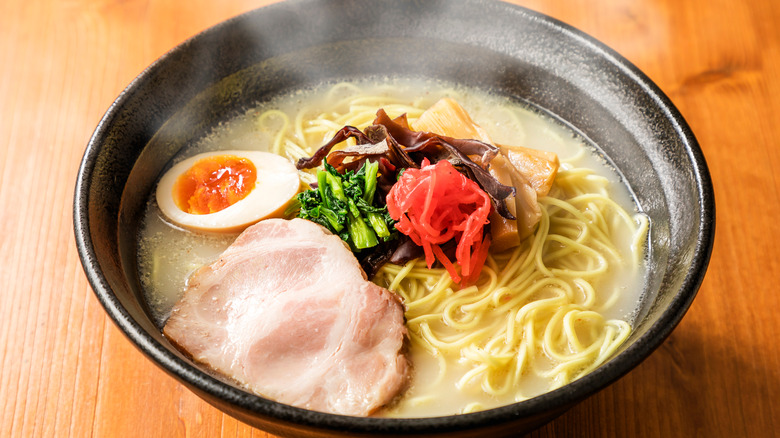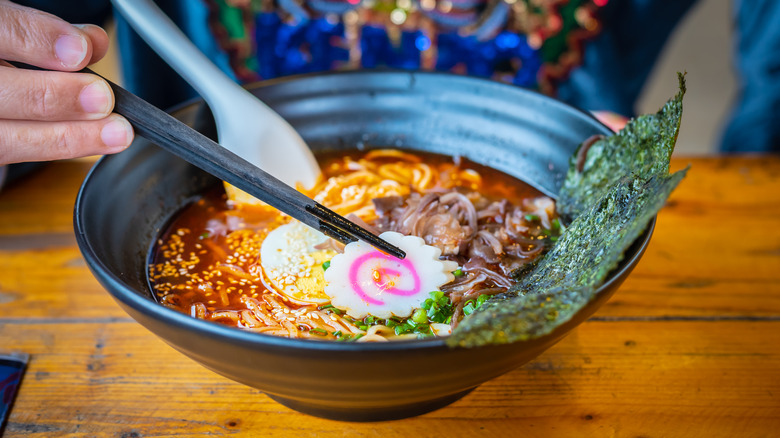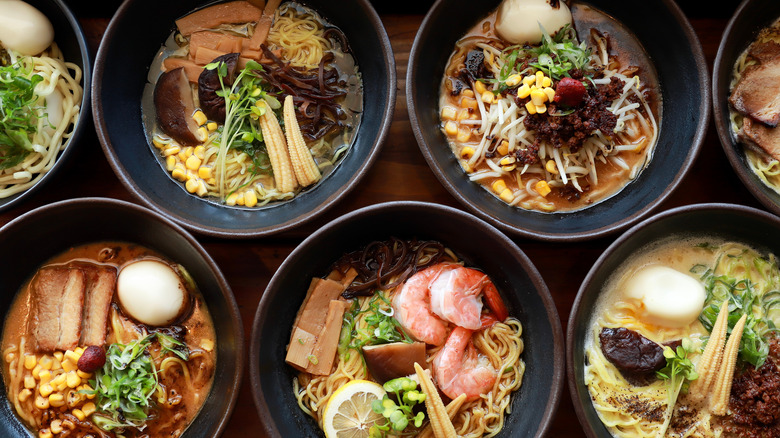The 4 Main Japanese Ramen Styles Fans Need To Know
Unlike most Japanese restaurants found in many parts of the world and which serve a variety of entrees, many restaurants in Japan — particularly those found in neighborhoods and in smaller cities — are one-trick ponies that specialize in just one style of dish, per Japan Guide. This degree of specialization can have its cons and pros – if you go to a restaurant that serves just sushi, Japanese curry, gyudon or beef bowls, and yakitori, chances are you won't be able to order anything else, and you're committed to eating whatever they happen to serve. On the plus side, the cooks at these restaurants are very good at what they do.
Such is the case with ramen, which is often served at a "ramen-ya." And while that can sometimes mean you're able to order servings of dumplings (gyoza) or fried rice, for the most part what you'll get is a bowl of soup and noodles.
But these are not your run-of-the-mill soup noodles, because you can order noodles cooked to the bite you prefer (soft, medium, or firm), and topped with anything from chasu — or fatty pork belly — to eggs with a soft runny or gelatinous yolk; bean sprouts to shiitake mushrooms, and dried seaweed sheets to fermented bamboo shoots known as menma, per MasterClass. And if the ramen-ya has the know-how, you're even able to pick one of several broths that your ramen can be served in — and it is this broth that can make or break the dish.
There are 2 categories of broth
Like pasta, ramen in Japan is a blank slate that can be dressed up to the nines not just with a range of specialty toppings, but with the broth of your choice. Per MasterClass, there are usually two categories of broth which ramen soups generally fall under.
One category of broth is clear and light, known as "chintan," where stock made with chicken, vegetable, or seafood soup can be mixed with a traditional Japanese soup base known as dashi. Dashi is used in different dishes and is made by soaking ingredients like bonito flakes, dried shiitake mushrooms or dried scallops in either cold or warm water, per Bon Appetit.
Then there is also a cloudier, richer broth known as "paitan," which MasterClass describes as "full of fat, and silky in texture due to gelatin, which forms when the collagen-rich connective tissue is cooked at a high temperature." It is with one or the other that ramen broth is usually made.
4 main types of ramen soups
Beyond chindan and paitan there are four types of soups that can be served as a base for ramen — but the number of options can increase when a restaurant chooses to put its signature spin on the soup.
On the lighter end of the ramen broth scale is "shoyu" — which is also the same Japanese word for soy sauce, and that, per Food and Wine, is what this broth is flavored with. The style delivers a chintan-style clear soup which was said to have been pioneered by a Tokyo ramen shop named Rairaiken — which also lays claim to being the country's first ramen restaurant, per The Smart Local. MasterClass says this type of ramen broth is usually made with chicken.
Tonkotsu ramen, which is made by simmering pork bones for hours is what a rich Paitan broth looks and tastes like. The soup is cloudy, nearly milky white thanks to the collagen which is released as the bones simmer, and Food and Wine says it is not uncommon to have pork or chicken fat already added to the rich tonkotsu broth.
In between both ends of the ramen broth spectrum are shio and miso — shio ramen, per MasterClass, is a light broth made with seafood and liberally seasoned with the sea salt for which it is named. It is native to the northern Japanese city of Hakodate. Miso can be made with pork, chicken, or fish stock and is flavored with miso, or fermented soybean paste.


